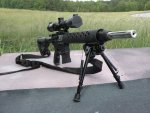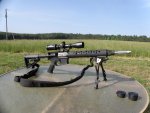There are differences in lowers that can help aid in achieving better accuracy, but most differences are either cosmetic or ergonomic (Ambi controls). Here are some, and note, these may or may not be valuable to you. It's a matter of personal preference for most.
1. Upper/Lower tension adjustment: some lowers have set screws machined into the lower allowing you to adjust the tension relative to how the upper receiver mates to the lower.
2. Over travel adjustment: some lowers have a set screw machined into the receiver that allow you to adjust the amount of over travel you have in your trigger unit. This can be a non-issue depending on the type of trigger you select.
3. Ergonomics I: some lowers include proprietary Ambi controls machined specifically for that lower (AXTS, San Tan, latest KACs & LWRCs, Gen 4 POF). It's valuable if you'll use the Ambi controls, but they come at a little higher price point and you're somewhat limited in replacement parts to that one MFGer. Some of the Ambi components can be installed on a non-Ambi lower via aftermarket parts available. Those include Ambi mag releases - like the Norgon and a slew of others that vary in the placement of the release mechanism, and the "through the trigger housing" types of bolt releases like the Magpul BAD lever and the Phase 5 release lever. Some lowers (Seekins for example) have some of these components like a right side bolt release, but not an Ambi mag release.
4. Ergonomics II: some lowers have sling attachment points (usually flush cups) already machined into the rearward section of the lower. Some like them designed as such, but there are also various options - receiver extension plates and some buffer tubes like the PWS EBT - that give you the same capability. If you plan on using a stock like Troy's M7A1 PDW stock, or the NEA CCS, the flush cups on the receiver take up to much space for the the guide rods to install and, hence, you'd have to choose another stock all together.
5. Safety: any receiver can accept the various aftermarket Ambi safeties. The battle arms BAD-ASS is probably the most versatile with the 8 different selector lever designs to choose from. The biggest difference related to the receiver itself would be the ability to accept a 45 degree short throw safety. A few do, most do not. This is completely personal preference IMO.
6. Mag well: the only other thing I can think of would be mag well designs. Most these days have flared openings of varying degrees to allow for easy, quick reloads. Some magwells won't reliably accept surefire high cap mags should one be planning on using them.
7. Ease of Install: if you're starting with a stripped lower, note that some of the more tedious tasks are made easier with receivers that are machined to accept threaded pins rather than tension pins used to install some or all of the springs and detents. This doesn't effect performance in any way though. Another personal preference difference.
I'd just pick which of those, if any, hold value for you based on who, how and for what it will be used. Simply find one that has those specific components and go from there. Hope that helps and good luck with the build!




